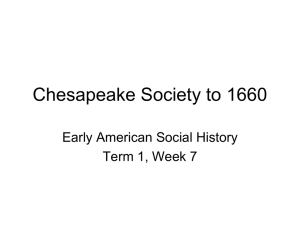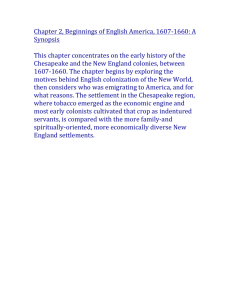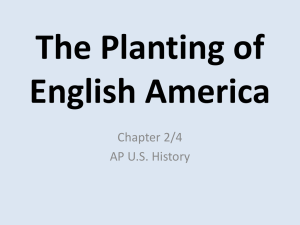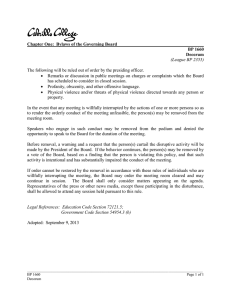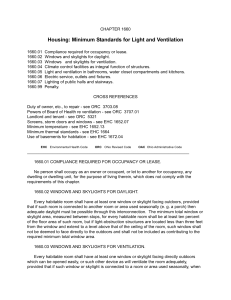Chesapeake Society to 1660 Early American Social History Term 1, Week 8
advertisement
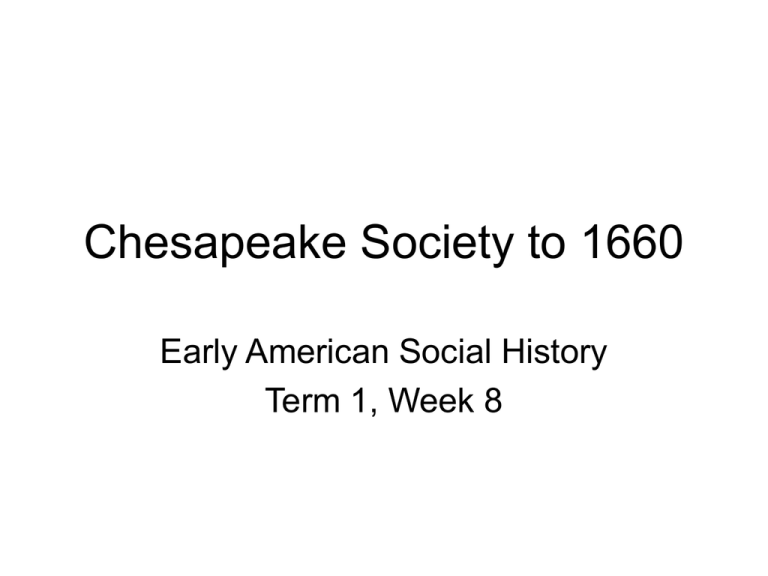
Chesapeake Society to 1660 Early American Social History Term 1, Week 8 Introduction • Transition from chaotic society, clinging on to shores of Chesapeake to much more permanent and secure one. • Geog spread of white settlement • Political, economic and social development over very short period of time. Maryland • Charter granted to George Calvert, Lord Baltimore, 1632, first settlers 1634. Proprietory colony. • Settled St Mary’s city, healthier location than Jamestown • Knew tobacco would be the main crop • LB’s brother sent as governor. • Maryland = haven for Eng catholics, LB tries to reserve all colonial positions for them, but unworkable, since significant nos of prots in colony – leads to Toleration Act of 1649, v. imp piece of legislation. Lord Baltimore Maryland’s Colonial Currency An act concerning religion Maryland Toleration Act, 1649 • ...whatsoever person or persons shall from henceforth upon any occasion of offence otherwise in a reproachfull manner or way declare call or denominate any person or persons whatsoever inhabiting, residing, traficking, trading or comercing within this province or within any ports, harbours, creeks or havens to the same belonging, an Heretick, Schismatick, Idolator, Puritan, Independent Presbyterian, Antenomian, Barrowist, Roundhead, Seperatist, Popish Priest, Jesuit, Jesuited Papist, Lutheran, Calvenist, Anabaptist, Brownist or any other name or term in a reproachful manner relating to matters of Religion shall for every such offence foreit and lose the sum of ten shillings Sterling or the value thereof to be levied on the goods and chattels of every such offender and offenders... • and if they could not pay, they were to be "publickly whipt and imprisoned without bail" until "he, she, or they shall satisfy the party so offended or grieved by such reproachful language...." Demographics • Va popn before 1624 mainly young and male, women only in significant nos after 1618. • Sale of women for 50 lbs tobacco • Women still in minority eg 1660 5 men to every woman • But youthful violence tempered as families start to appear, and planters invest more to provide for family futures. • Yet families do not ease reliance on immigration due to high death rates. Early Death • 30% of settlers died each year • Third of children orphaned by 18 (two thirds lost one parent), so few nuclear families • Causes of death: malaria (esp dangerous to those weakened by voyage); dysentery (‘Bloody Flux’) since no running water in Jamestown; salt water poisoning; Indian warfare; psychological factors (‘give-up-it is’) Impact of Early Death • Psychological – climate of fear and dread • Lack of authority (parents) • Lack of experience (skills need to be relearned, mistakes repeated) • Community responsibility for orphans • Power of widows (‘widowarchy’), through remarriage etc. • 50% infant mortality rates = reliance on immigrants • Fosters culture of hedonism and undermines attempts at social stability Social Mobility • Early Death means society relatively fluid and mobile. • Possible for indentured servants to gain lands under headright system and become planters, JPs, assemblymen etc (Menard article) • Most commonly freed servants migrate to frontier zones where land not yet allocated to mark out a claim, causes conflict with Indians Political Developments • 1624 charter of Va Co revoked. • House of Burgess (1619) remained, new council and a governor appt by King • H of B begins to assume role of H of C in England, eg control over finances, militia etc. • By end 17thC H of B able to initiate legislation • Council appt by Gov, mainly leading planters – functions like H of L. • High death rates ensure rapid turnover of members William Berkeley Governor of Virginia 1642-52; 1660-76 Economic Development • Tobacco still most important cash crop • Price stabilisation of the 1620s takes excessive profit out of market, encourages longer term investment • First Africans arrive in Virginia c. 1619, status not clear, perhaps slaves, perhaps indentured servants. Slavery not than imp before 1660 Stability/Instability • Historiographic debate; Bailyn/Morgan saw Ches soc as very unstable; Kukla argues more stable than thought • Kukla points to end of Indian wars, civilian govt, brick houses (permanency) • stability is characterised by: low levels of collective violence, absence of division, acceptance of governmental authority, few changes of leadership, and when changes occur, they are orderly. Factors of Stability (Diamond, 1958) • a) religion, with the C of E becoming more prominent • b) creation of local hierarchy of gentry who served on the council • c) creation of assembly which gave the lower classes a role in political society • d) end of conditions of land ownership which encourages migration • e) increased migration of women etc, Virginia becomes more demographically stable • f) introduction of cash crop, tobacco, which allowed the colonists to pay for things they otherwise could not afford. Depth of White Settlement by 1660 Conclusions • Chesapeake definitely more stable in 1660 than in 1624. • Political govt normalised, economic future secure, Indian threat neutralised. • Demographics slowly normalising, birth rate rising, death rate slowly falling. • Future much more certain.
